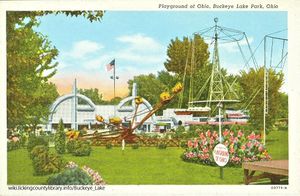Buckeye Lake Amusement Park
Buckeye Lake Amusement Park
The Buckeye Lake Amusement Park opened in 1901 and was referred to as “The Playground of Ohio.” In its heyday, crowds as large as 50,000 would come to visit the attractions, which included rides, a skating rink, boating excursions, swimming, and dining. The park also had two large ballrooms, The Crystal Ball Room and Lake Breeze Pier Dance Hall, which often hosted popular big bands including Louis Armstrong and Tommy Dorsey.[1] Radio broadcasts that could be heard across the country were also recorded in the Pier Ballroom. [2]The park unfortunately experienced its fair share of tragedies. In 1922, a tornado killed several people and destroyed some of the park’s rides. In 1924, the Lake Breeze Hotel’s ballroom, which was being used by the Colored Elks Number 82, collapsed, causing many of the dancers to fall into the lake. Many of the dancers were injured, and seven were killed. Over the years, fires destroyed the Lake Breeze hotel and several other buildings. [3]
As bigger amusement parks began to sprout up around Ohio and dance halls became less popular, crowds began to decline. This led to the park’s closure in the early 1970s. [4] A historical marker along with a fountain now pays tribute to where the park once stood. [5]
C.P.
Cranberry Marsh
The Cranberry Marsh, located in Buckeye Lake, is a bog left over from the last Ice Age, which occurred about 12,000 years ago.[6] The marsh exists because of acidic soil that was brought via a glacier from Canada. Without that soil, cranberries would be unable to grow in Ohio.[7] Cranberry Marsh is considered a “floating island,” meaning that it is entirely composed of sphagnum moss and other compacted vegetation.[8] The marsh first appeared in 1830, when the lake was created as a reservoir for the Ohio canal system. During this time, the marsh covered about 50 acres. Unfortunately, due to deterioration, only a small portion of Cranberry Marsh has survived into the 2010s.[9]
In 1992, the Ohio Department of Natural Resources announced that this Cranberry Marsh is the only floating bog in the world. To help slow the deterioration of the marsh, public access has been restricted to the bog. Visitors are not allowed at the Cranberry Marsh, except for members of guided tours.[10] Over the years, these tours became very limited, and are now only held once a year. In order to decide the participants, individuals are drawn on a lottery based system, creating a fair and easy process.[11]
M.J.
References
- ↑ Shinn, Dave, “Playground of Ohio”.
- ↑ Shinn Dave, “Buckeye Glory Days”, The Licking Countian.
- ↑ Bonar, Daniel and Anthony Lisska. “The Big Swamp: The Licking Summit Reserve Buckeye Lake. The Historical Times, 1991. 6-7.
- ↑ Shinn, Dave, “Playground of Ohio”.
- ↑ Graff, Kevin. “Marker Pays Tribute to Buckeye Lake Site”. The Advocate. May, 4, 2002.
- ↑ “Cranberry Bog vanishing from Buckeye Lake,” Licking Countian, June 25, 1987.
- ↑ “Cranberry marsh berries are tender and sweet,” The Advocate, November 25, 1971.
- ↑ ‘Cranberry bog nature preserve,” The Licking County Convention and Visitors Bureau.
- ↑ “Cranberry Bog vanishing from Buckeye Lake,” Licking Countian, June 25, 1987.
- ↑ “Cranberry Bog: One of a kind,” Licking Countian,” June 25, 1992,6.
- ↑ Julie Shaw, “Lottery to pick Cranberry Bog visitors,” The Advocate, April 30, 2002.
